Application security is always important, and even more so when the application is delivered across a public network, such as the Internet. Salesforce.com has developed various mechanisms to secure the platform and reduce the chances of unauthorized people accessing your company data. This chapter describes the way login attempts to the system are controlled and the features available to help you manage your users' access to the Salesforce CRM application.
In this chapter, you will also look at establishing your company profile within Salesforce and how core information, such as the details that are provided when your company first signs up with Salesforce.com, can be managed.
You will also be introduced to the settings available for organization-wide customizing of the application's user interface along with a detailed description of the searching facilities offered by the Salesforce CRM application.
Throughout this chapter, notes and tips are provided that are intended to offer further guidance within the areas of functionality, and have been generated from the practical results and experience of Salesforce CRM system administration.
In this chapter, we will cover:
User login and authorization
Company profile
User Interface
Search options
To start, we will look at how users' login requests are verified and authorized by the Salesforce CRM application.
Organizations have several methods of accessing the Salesforce CRM application. Access can be gained from either the user interface (using a web browser), the API (for example, using an integrated client application or the Apex Data Loader), a desktop client (for example, Salesforce for Outlook), or from a mobile client application.
Whenever a login attempt is made to Salesforce using any of these preceding methods, the user's login request is authorized by the system using the following sequence of checks:
Does the user's profile have any login restrictions?
Does the user's IP address appear within the organization's trusted IP address list?
Has the user been activated from this IP address before?
Does the user's web browser have a valid browser cookie stored from Salesforce?
If the user's login is from neither a trusted IP address nor a browser with a valid Salesforce cookie, the login is denied. To gain access to Salesforce, the user's identity must be confirmed by successfully completing the computer activation process.
Login hour and IP address restrictions can be set for the user's profile. If these are set and there are login attempts from a user outside the specified hours or from an unknown IP address, access is denied.
If login hour restrictions are set for the user's profile, any login attempt outside the specified hours is denied.
To navigate to the Profile menu, go to Your Name | Setup | Administration Setup | Manage Users | Profiles. Now select a profile and click on Edit in the Login Hours related list.
Set the days and hours when users with this profile can login to Salesforce.com.
The login hours that are set are based on the default time zone of the organization, as described later in this chapter. Navigate to Your Name | Setup | Administration Setup | Company Profile | Company Information and select the required time zone from the Default Time Zone picklist.
The login hours that are set apply strictly to that exact time, even if a user has a different personal time zone or if the organization's default time zone is changed.
To allow users to login at any time, click on clear times as shown in the following screenshot:

If IP address restrictions are defined for the user's profile, any login attempt from an unknown IP address is denied.
To restrict the range of valid IP addresses through the Profile menu, navigate to Your Name | Setup | Administration Setup | Manage Users | Profiles. Now select a profile and click on the New in the Login IP Ranges related list.
Enter a valid IP address in the Start IP Address field and a higher IP address in the End IP Address field.
The start and end addresses specify the range of IP addresses from which users can login. To allow a login from a single IP address, enter the same address in both fields.
For example, to allow a login from only 88.110.54.113, enter 88.110.54.113 as both the start and end IP addresses as follows:

This check is performed if profile-based IP address restrictions are not set.
If the user's login is from an IP address listed in your organization's trusted IP address list, the login is allowed.
To navigate to the Trusted IP range settings, go to Your Name | Setup | Administration Setup | Security Controls | Network Access.
Click on New and enter a valid IP address in the Start IP Address field and a higher IP address in the End IP Address field.
The start and end addresses specify the range of IP addresses from which users can login. To allow a login from a single IP address, enter the same address in both fields.
For example, to allow a login from only 88.110.54.113, enter 88.110.54.113 as both the start and end addresses as follows:

Each user has a list of IP addresses from which they've been activated. If the user has previously been activated from this IP address, then this IP address is added to the user's personal list and is never challenged again.
The browser will have the Salesforce cookie if the user has previously used that browser to login to Salesforce and has not cleared the browser cookies.
So, if the user's login is from a browser that includes a Salesforce.com cookie, the login is allowed.
A cookie is a small file containing a string of characters that is sent to your computer when you visit a website. Whenever you visit the website again, the cookie allows that site to recognize your web browser.
If the user's login is from neither a trusted IP address nor a browser with a Salesforce cookie, the login is denied and becomes blocked, and Salesforce must verify the user's identity.
A trusted, genuine user can access the Salesforce CRM application using the following means:
User interface (using a web browser)
API (for example, using an integrated client application or the Apex Data Loader)
Desktop client (for example, Salesforce for Outlook)
For access through the user interface, the user is prompted to click on the Email me a verification code button to send an activation e-mail to the address specified in the user's Salesforce user record as follows:

On clicking the Email me a verification code button, a new screen is presented to allow the entering of a verification code as shown in the following screenshot:

Salesforce sends the verification code e-mail to the e-mail address associated with the user's record in Salesforce. Here, the following screenshot shows an e-mail example:

The e-mail instructs the user to enter the verification code into browser to activate laptop for login to Salesforce.
The activation code within the e-mail is valid for up to 24 hours from the time the Email me a verification code button was clicked. After 24 hours, the activation link will expire and the user must repeat the activation process.
Confusion can occur if your company has remote users that connect to Salesforce away from the company network such as from home or from public Internet connections. The remote users are likely to have dynamically assigned IP addresses set as their computer identity. Hence, whenever they attempt to login, Salesforce will identify it as an unknown IP address, prompt for verification, and the remote user will have to click on the verification button.
The remote user will then have to access the e-mail associated to their Salesforce user record to retrieve the activation e-mail, and it is here where confusion can occur. If the remote user has to access corporate web e-mail using a VPN (Virtual Private Network) connection, the clicking of the activation link may not work because the IP address that is being validated may now no longer be the same IP address used by the browser. This is because the VPN connection may likely be using a web proxy.
For access using the API or a desktop client (for example, using the Apex Data Loader), the user must add his/her security token at the end of the password in order to log in. A security token is an automatically generated key from Salesforce. For example, if a user's password is pa$$word, and their security token is XXXXXX, then the user must enter pa$$wordXXXXXX.
Users can obtain their security token by changing their password or resetting their security token via the Salesforce.com user interface by navigating to Your Name | Setup | Personal Setup | My Personal Information | Reset My Security Token and then clicking on the Reset Security Token button.
When a user changes their password or resets their security token, Salesforce sends a new security token to the e-mail address associated to their Salesforce user record. The security token is valid until a user resets their security token, changes their password, or has their password reset by a system administrator.
Note
Do not enter a security token within your password when accessing Salesforce from a web browser.
It is recommended that you obtain your security token via the Salesforce user interface from a trusted network prior to attempting access from a new IP address.
When a user's password is changed, the user's security token is automatically reset. The user will experience a blocked login until they add the security token to the end of their password or enter the new password after you have added their IP address to the organization's trusted IP range.
The company profile contains core information for your organization within Salesforce, some of which is captured during the initial system sign-up, and includes:
Company information and primary contact details
Default language, locale, and time zone
License information
Fiscal year settings
Currencies and exchange rates
My Domain
When your company signs up with Salesforce, the information provided is displayed on the Company Information page. This page can be accessed by navigating to Your Name | Setup | Administration Setup | Company Profile | Company Information.
From the Company Information page, you can edit the company default localization settings and primary contact details:
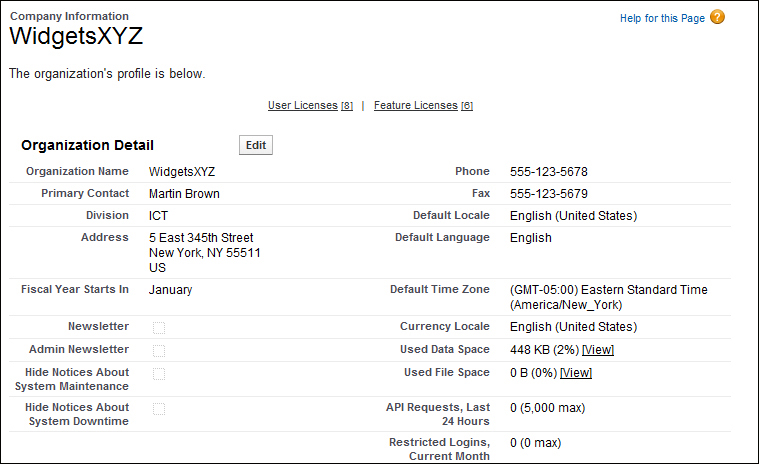
The company information settings for language, locale, and time zone can affect how key data is handled for the organization.
However, individual users can set their own language, locale, and time zone which will override the organization-wide setting by navigating to Your Name | Setup | Personal Setup | My Personal Information | Personal Information.
This is the primary language for the organization. All interface text and online help is displayed in this language. Individual users can, however, set their own language which will override the organization-wide setting.
Tip
For global organizations, it is recommended that you consider how the setting of language impacts, user's ability to access and share information, and whether a common language is preferred to aid reporting and system administration.
You can use the feature called Language Settings (described later) to restrict the languages that your users can set in their personal information language setting.
The default locale setting affects the format of date, date/time, and number fields.
For example, a given date in the English (United States) locale would appear as 07/27/2012, and in the English (United Kingdom) locale as 27/07/2012.
Time in the English (United States) locale is displayed using a twelve hour clock with AM and PM (for example, 3:00 PM), whereas in the English (United Kingdom) locale, they display using a twenty-four hour clock (for example, 15:00).
Numbers in the English (United States) locale would be displayed as 1,000.00 and in the German locale as 1.00,000.
However, individual users can set their own locale which will override the organization-wide setting.
This is the primary time zone in which your organization is located, for example, the head-office location. However, individual users can set their own time zone which will override the organization-wide setting.
The Company Information page also displays all of the base licenses, active users, and feature licenses that have been purchased by your organization.
A user license entitles a user to different functionality within Salesforce and determines the profiles available to the user. A feature license entitles a user to an additional Salesforce feature, such as Marketing or Connect Offline.
Currency settings are organization-wide within Salesforce and can be set using either a single currency option using the Currency Locale setting on Company Profile, or as a multiple currencies option where you can add currencies and set conversion rates using the Manage Currencies link within, Company Profile section.
Note
Multiple currencies can only be enabled by a request to Salesforce customer support. When activated, the Currency Locale field and its value is passed to a new field, Corporate Currency, also on Company Profile.
The corporate currency reflects the currency in which your company reports revenue, and is used as the rate that all other currency conversion rates are based on. This is initially set by Salesforce.com when the Salesforce application is activated.
All organizations, whether using single or multiple currencies, are by default with only one currency at Company Profile accessed by navigating to Your Name | Setup | Administration Setup | Company Profile | Company Information, and setting either the Currency Locale field or the Corporate Currency field respectively.
In a single currency organization, you set the organization-wide currency locale for your company and your Salesforce users cannot set individual currency locales.
In a multiple currency organization, you set the corporate currency instead of the currency locale, and your Salesforce users can also set their individual currency by navigating to Your Name | Setup | Personal Setup | My Personal Information | Personal Information.
Your Salesforce user's individual currency is used as the default currency in their own reports, quotas, forecasts, and any records that contain currency amounts, such as opportunities.
Note
Currency becomes a required field on records where it has been added or was originally defined, and so must be considered when activating the Multiple Currencies option and then importing data or custom object creation.
Users can also create opportunities (and all other data records that contain currency amounts) using any other available active currency.
The list of active currencies represents the countries or regions in which your company trades. Only an active currency can be set by you, as the system administrator on the organization profile, or by your users on their individual user records or on data records in the currency field.
The Manage Currencies section enables you to maintain the list of active currencies and their conversion rates in relation to the corporate currency, and can be accessed by navigating to Your Name | Setup | Administration Setup | Company Profile | Manage Currencies.
Note
The Manage Currencies option appears when your organization has enabled Multiple Currencies, currently available by request to Salesforce customer support.
Changing the conversion rates will update all existing records with the new conversion rates, even the closed opportunities. As a result, you will not be able to measure financial changes due to the effects of currency fluctuations unless you have implemented Advanced Currency Management, which stores dated exchange rates.
Dated exchange rates allow you to track conversion rates when an opportunity closes, enabling the accurate reporting of opportunity converted amounts based on the rate that was set at the opportunity's close date. This is made possible because the historic conversion rates are stored, and rate changes after that close date can be tracked. Therefore, reports can include the opportunity amount based on the conversion rate at the close date instead of the rate at the time that the report is run.
Note
Updating currency conversion rates will not change the original opportunity amounts, only the converted amounts. Accounts and their associated contacts must use the same default currency.
Account and contact records may be imported using active or inactive currencies. However, importing lead records must use active currencies only.
A lead is a potential sales opportunity or prospect, which has either expressed interest or has been identified as someone who may have an interest in your company's offerings.
Dated exchange rates are activated by setting the Advanced Currency Management option, and are used for opportunities, opportunity products, opportunity product schedules, campaign opportunity fields, and reports related to these objects and fields.
When Advanced Currency Management is first enabled, your existing exchange rates automatically become the first set of dated exchange rates.
These exchange rates will be valid until you set another set of exchange rates by navigating to Your Name | Setup | Administration Setup | Company Profile | Manage Currencies, Manage Dated Exchange Rates.
If you enable Advanced Currency Management, you cannot create roll-up summary fields that calculate currency on the opportunity object. Any existing currency related roll-up summary fields on the opportunity object will be disabled and their values will no longer be calculated.
Note
How do you convert currency amounts automatically using the Data Loader?
In a Salesforce organization with multi-currency enabled, when you change the currency on a record via the browser, currency amounts on that record are not updated. Thus, if you change the currency of an opportunity whose amount is 5000 from USD to EUR, the amount remains 5000 and is not converted from USD 5000 into EUR 3900 (based on a USD:EUR exchange rate of 1:0.76).
However, currency amounts are converted when you change record currency using the Data Loader. This means that changes to the currencies of records will cause a mass recalculation of any currency fields on those records.
To change the currency of records using the Data Loader, update the CurrencyIsoCode field with the three-letter ISO code of the currency you want to set. For example, USD for US Dollars, EUR for Euros, and so on.
The fiscal year settings in Salesforce can be set by navigating to Your Name | Setup | Administration Setup | Company Profile | Fiscal Year.
The fiscal year settings in Salesforce by default use the Gregorian calendar year (twelve month structure) starting from January 1 and ending on December 31. If your organization follows the twelve month structure, you can use the standard fiscal years. Standard fiscal years can start on the first day of any month, and you can specify whether the fiscal year is named for the starting or ending year. For example, if your fiscal year starts in April 2012 and ends in March 2013, your fiscal year setting can be either 2012 or 2013.
If your fiscal year is more complicated than this, you can define these periods using custom fiscal years. For example, as part of a custom fiscal year, you can create a 13-week quarter represented by three periods of 4, 4, and 5 weeks, instead of calendar months.
If you use a fiscal year structure, such as a 4-4-5 or a 13-period structure, you can define a fiscal year by specifying a start date and an included template. If your fiscal year structure is not included in the templates, you can modify a template. For example, if you use three fiscal quarters per year (a trimester) instead of four, delete or modify the quarters and periods to meet your needs. These custom fiscal periods can be named based on your standards. For example, a fiscal period could be called P12 or December.
Fiscal years can be modified any time you need to change their definition. For example, an extra week could be added to synchronize a custom fiscal year with a standard calendar in a leap year. Changes to fiscal year structure take effect immediately upon being saved.
My Domain allows you to set a custom Salesforce.com subdomain name as your Salesforce login as well as navigation URLs to uniquely identify your company.
Using a custom domain name provides benefits such as increased security and better support for single sign-on (a way to authenticate login using your company network). This feature can be set by navigating to Your Name | Setup | Administration Setup | Company Profile | My Domain.
You enter the name you want to use (anything up to 40 characters) and then click on Check Availability to see if it is available. For example, the login URL for a company called WidgetsXYZ could be set as https://widgetsxyz.my.salesforce.com.
You will receive an e-mail when your domain name is ready (after 24 hours to 72 hours), and included in the e-mail is the URL to log in to Salesforce with the new domain name.
Tip
There is a Salesforce site called trust.Salesforce.com that lists live system performance and maintenance details for various regional servers known as instances (a subdomain of the standard XXX.salesforce.com URL).
To get this instance information from your new domain name, navigate to http://trust.salesforce.com and click on the System Status tab. Enter your domain name in the My Domain Lookup search field (on the top-right of the page) to find your system instance and check the status.
Scroll to the System Maintenance table and look for entries for your instance.
The Language settings feature allows you to specify the acceptable languages that can be used within the Salesforce CRM application.
This feature can be set by navigating to Your Name | Setup | Administration Setup | Company Profile | Language Settings.
You then choose the languages that you want to make available to users by selecting them from the Available Languages pick list and then clicking on Add.
In the following example, we have added Spanish and French along with English, and these appear in the Displayed Languages list:
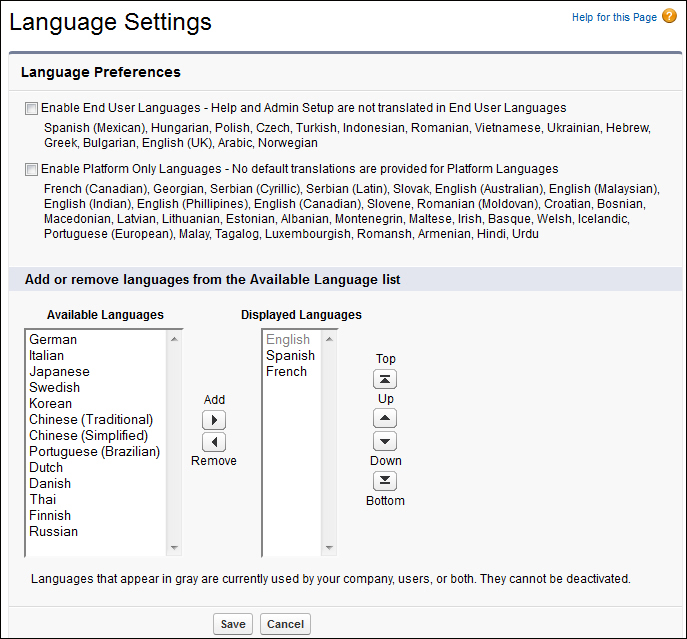
The languages that appear in the Displayed Languages list are now shown as available options in the Language picklist section on user's Personal Information pages as shown in the following screenshot:
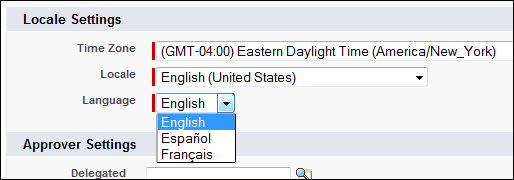
Salesforce currently has two user interface themes: the Classic Theme and the New Theme. Starting with the summer 2010 edition (released in June 2010), all new organizations are enabled by default with the new user interface theme.
All screen image capture and setup in this book has been undertaken using the new user interface theme. The difference in themes can be seen in the following screenshot, which appears when you attempt to change from the Classic to New theme:
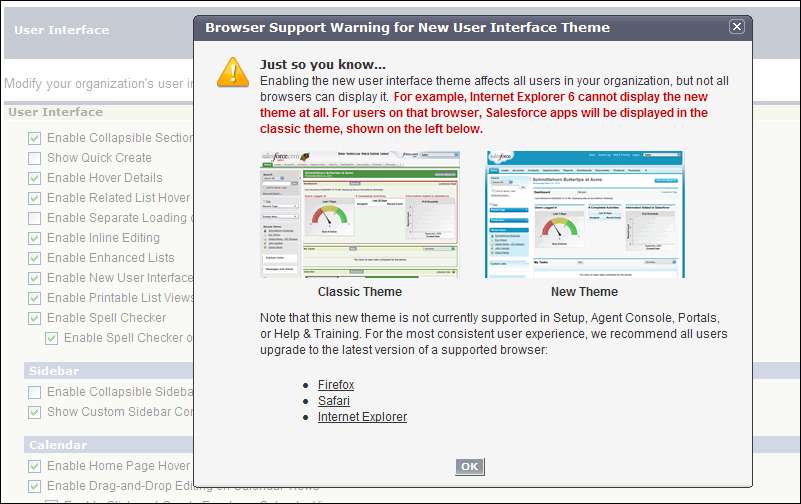
Not only does the new user interface theme change the look and feel of Salesforce, but it also positions some key links such as Setup and Logout under the user name for each user in your organization.
Note
The new user interface theme is seen only by users with supported browsers. Supported browsers include Microsoft Internet Explorer (IE) 7, 8, 9, and 10, Firefox (the most recent stable version), Apple Safari Version 5.1.x for Mac OS X, and Google Chrome (the most recent stable version).
Neither IE 6 nor the Metro Version of IE 10 is supported. Safari on iOS is not supported.
Some newer functional areas are dependent on the New Theme and cannot be provided when the Classic Theme is activated, such as Chatter (a collaboration application suite). Therefore, to enable Chatter, you must first activate the New Theme.
Along with the user interface theme, there are many other aspects of the user interface that can be set up in Salesforce to present the optimum user experience for the users in your organization.
Additional user interface options include, User Interface settings (such as collapsible detail page sections and inline field editing), Sidebar settings (Collapsible Sidebar settings and Custom Sidebar Components on All Pages), and Calendar settings (such as Home Page Hover Links for Events and Drag-and-Drop Editing on Calendar Views).
There are also some administrator-specific settings that can improve your experience with the application located under the Setup settings. It also includes the Enhanced Page Layout Editor and Enhanced Profile List Views settings.
The selection of the User Interface option can be carried out by navigating to Your Name | Setup | App Setup | Customize | User Interface.
Note
The User Interface option is the final option on the Customize section on the left-hand setup sidebar.
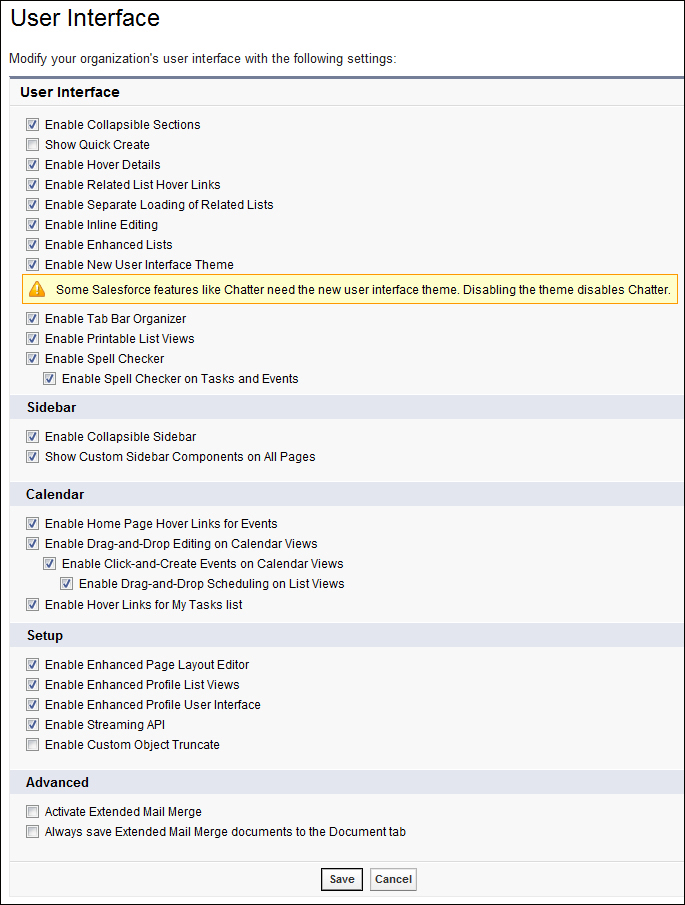
In the following sections, we will look through the various User Interface settings. Let's look at the various User Interface settings one by one:
Collapsible Sections enables your users to collapse or expand sections on record detail pages using the arrow icon next to the section heading. Sections remain expanded or collapsed until the user changes their settings for that section. Salesforce will store a different setting for each record type if the record types have been set up as follows:
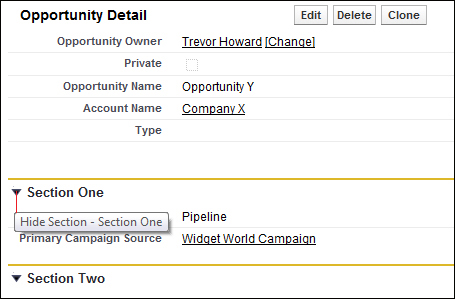
Note
When enabling collapsible sections, you need to ensure that the section headings have been entered on the page layouts.
Clicking on the triangle icon toggles between showing and hiding the section, as shown in the following screenshot:
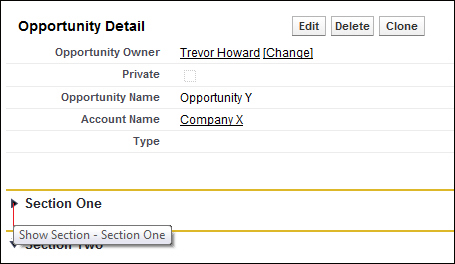
The Show Quick Create option adds the Quick Create fields section to the sidebar on a Record tab page to enable users to create a new record using minimal data fields as follows:
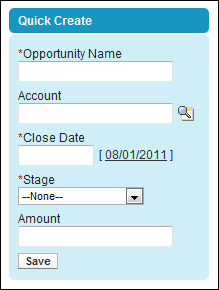
The Show Quick Create option also controls whether users can create new records from within the lookup dialogs. With the setting enabled, users see a New button in the lookup dialog screen. The following example shows the creation of a new account within the account lookup dialog while working with an opportunity record:
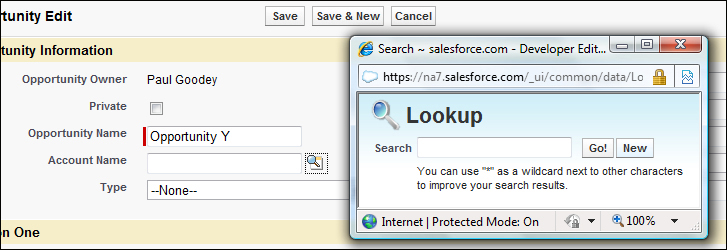
Clicking on the New button reveals the fields that are available for creating the new record:
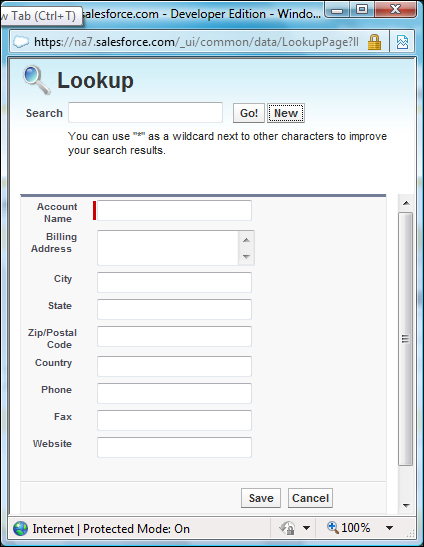
The option to create new records and the display of the New button in the lookup dialog is only available for accounts and contacts. Also, users still need the appropriate Create user profile permission to enter data with Quick Create in spite of whether the entry fields are displayed.
The Enable Hover Details option allows users to view interactive information for a record by hovering the mouse pointer over a link to that record in the Recent Items list on the sidebar or in a lookup field on the record detail page. The fields displayed in the hover details are determined by the record's mini page layout which is set at the page layout edit screen.
In the following screenshot, we are hovering the mouse pointer over a link to a record in the Recent Items list on the sidebar:
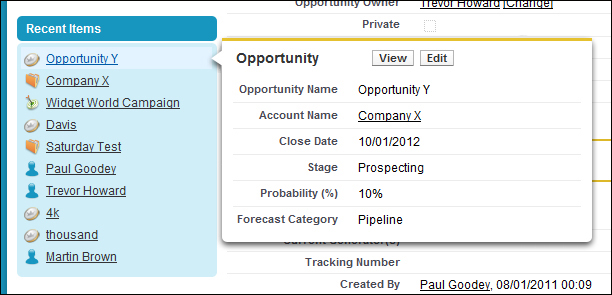
In the following screenshot, we are hovering the mouse pointer over a lookup field on the record detail page:
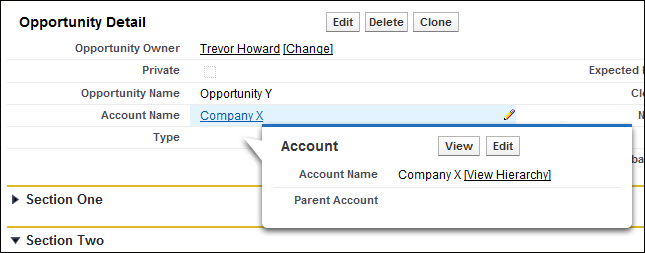
Note
To view the hover details for a record, users require the appropriate sharing access to the record and field level security to the fields in the mini page layout, which is set at the page layout edit screen (see Chapter 3, Configuration in Salesforce CRM).
This option enables related list hover links to be displayed at the top of standard and custom object record detail pages. It allows users to view the related list and its records by hovering the mouse pointer over the related list link. Users can also click on the related list hover link to jump down directly to the Related List section without having to scroll down the page.

This option enables a separate loading of record detail pages. First, the primary record detail data loads, and then the related list data. This option serves to improve the display performance for organizations with a large number of related lists on record detail pages. When the page is loaded, the record details are displayed immediately and afterwards, the related list data loads during which the users see a progress indicator for the related list.

You will see that the related list sections are not yet loaded. They appear as […] while the primary record detail (for the account example) is loaded immediately, as follows:

After the primary record detail has loaded (the account page), the related lists are then loaded. You can see that the number of records for the Contacts related list is now displayed as [2].
This option does not apply to pages for which you cannot control the layout (such as user pages or Visualforce pages).
This option allows users to change field values directly within the record detail page, avoiding the need to load the record edit page first. By double-clicking on the field to be edited within the detail page, the field changes to become editable. The new value can then be entered and saved or the action can be undone using the undo button.
First, the field is highlighted by hovering over it with the mouse to reveal the pencil icon indicating that the field is editable, as follows:

Then double-clicking the field causes the field to switch from a view mode to an edit mode to allow a new value to be entered, as follows:

After a new value has been entered, the value is displayed in orange text and the user has the option to undo the change using the undo button as follows:

The changed value and the detail page can then be saved in the standard way using the Save button, as follows:
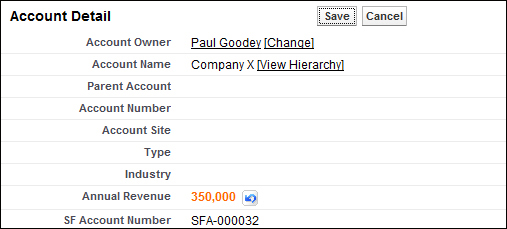
Tip
To check if inline editing is enabled for your organization and to discover which value can be edited, you can hover over a value with your mouse and note the following result:
It represents an editable field displayed by a pencil icon
It represents a non-editable field displayed by a lock icon
This option is enabled by default. Certain fields cannot be changed using inline editing, such as System Fields (created by, last modified by, and so on), Calculated Fields (formula, auto number, roll-up summary, and so on), Read-Only Fields, and Special Fields (such as owner and record type).
This option provides the user with the ability to view, customize, and edit list data, which is the resulting data section that is rendered from Views. When enabled along with the Enable Inline Editing setting, users can also edit records directly within the list without having to move away from the page, as shown in the following screenshot:

With enhanced lists enabled, users can:
Create a new view or edit, delete, or refresh the existing view.
Navigate through the list results by clicking the first page, previous, next, and last page links at the bottom of the list. You can jump directly to a specific results page by entering a number in the textbox in the lower-right corner. You can also change the width of a column by dragging the right side of the column heading with the mouse. Changes made to column widths apply to that specific list only and are recalled whenever that list is viewed. Please note that when columns are added or removed from a list, any column width setting for that list is discarded.
Change the order in which a column is displayed by dragging the entire column heading with your mouse to the desired position. For your users who have the permission to edit the list definition, the changes are saved for all who see the list. For your users without permission to edit the list definition, their changes are discarded after leaving the page.
If inline editing is enabled for your organization, values can be entered directly into the list by double-clicking on individual field values. Users who have been granted the Mass Edit from Lists option on their profile can edit up to 200 records at a time.
A mass edit is performed by first selecting the records to be edited using the checkboxes and then clicking on one of the fields that is to be edited.
Upon clicking on the field, a new pop-up window is displayed to prompt whether the change is to be done to just the selected record or to all the records that have been selected. In the following screenshot, we see an example where two account records have been selected, and where one of the record's billing street fields has been clicked:
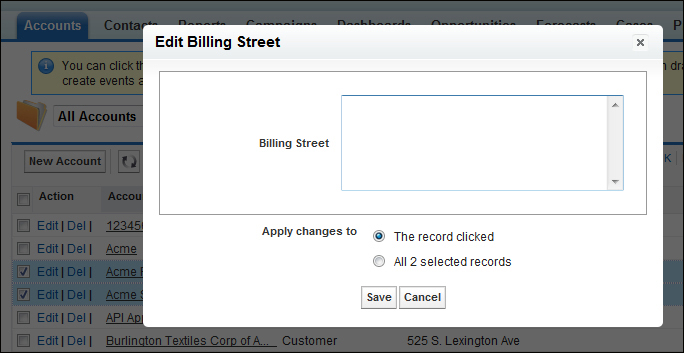
Tip
Remind users that they cannot mass delete records
As a system administrator you may need to remind users that they cannot mass delete records, as occasionally users may try to mass delete using the only visible Delete link, which is in fact the link to delete the View as shown in the following screenshot.
Communication of this fact will hopefully save you from having to recreate any views that have been deleted in error.
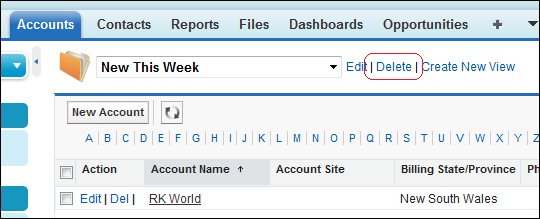
On Account, Contact, and Lead List views, there is an Open Calendar link at the bottom of the page to display a weekly view of a calendar underneath the list. A record can be dragged from the list to a time slot on the calendar to create an event associated with the record.
Note
To perform inline editing on an enhanced list, Advanced Filter options must be turned off in the list view filter criteria.
Some standard fields do not support inline editing. For example, Case Status, Opportunity Stage, and several of the Task and Event fields can only be edited from the record edit page.
The number of records displayed can be changed per page by setting the view for 10, 25, 50, 100, or 200 records at a time. When this setting is changed, navigation is set to the first page of list results as shown in the following screenshot:
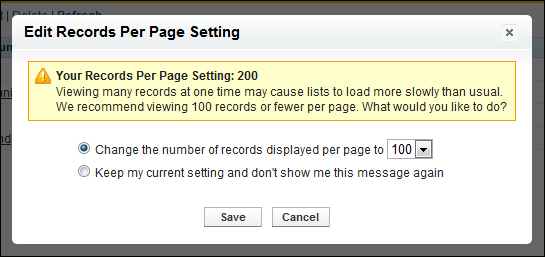
The New User Interface Theme changes the look and feel of Salesforce from the Classic Theme to the New Theme. It also houses the links, such as Setup, Developer Console, and Logout, under the user name for users in your organization.
There are still some older browsers (such as IE 6) that cannot render the New User Interface Theme and should be avoided.
Tab Bar Organizer automatically arranges users' tabs in the tab bar to control the width of the CRM application pages and prevent horizontal scrolling. It dynamically measures how many of the application tabs can be displayed and puts tabs that extend beyond the browser's current width into a drop-down list presented on the right-hand side of the tab bar as shown in the following screenshot:
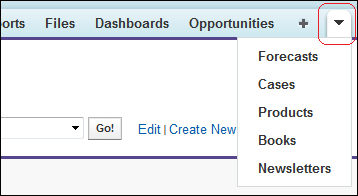
This option allows users to easily print list views.
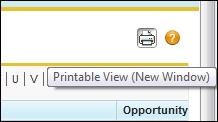
If enabled, users can click on the Printable View link (the printer logo) located in the top-right corner on any list view to open a new browser window. Within the new window, the current list view is displayed in a print-ready format, as follows:
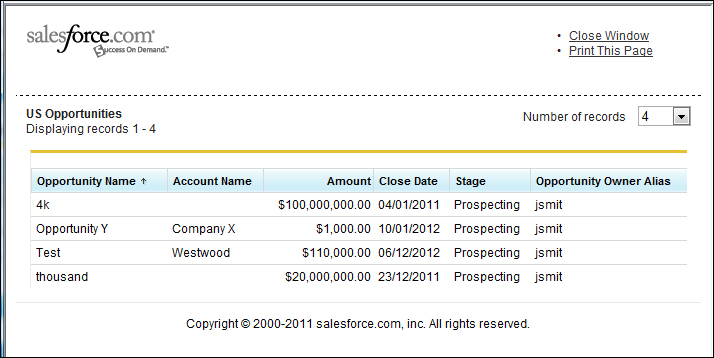
This option allows users to click on the Printable View link from any list view, which opens a new browser window displaying the current list view in a print-ready format.
When this option is selected, the Check Spelling button appears in certain areas of the application where text is entered, such as sending an e-mail, or when creating cases, notes, and solutions. Clicking on this button checks the spelling of your text as shown in the following screenshot:
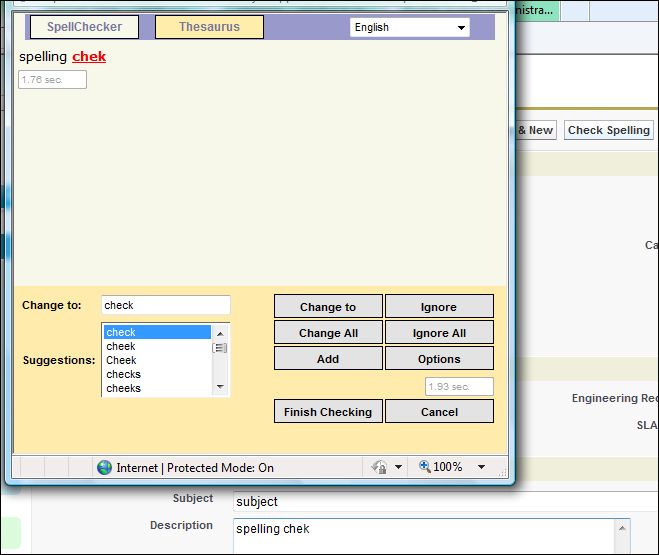
The settings for the sidebar options are as follows:
The collapsible sidebar gives users the ability to show or hide the sidebar on every Salesforce page where the sidebar is included. When this option is selected, the collapsible sidebar becomes available to all users in your organization. However, each user can set their own preference for displaying the sidebar. Users can set the sidebar to be permanently displayed or they can collapse the sidebar and show it only when needed.
If you have custom home page layouts that include components in the sidebar, this option displays the sidebar components on all pages in Salesforce and for all users. If only certain profiles are allowed to view sidebar components on all pages, you can assign a Show Custom Sidebar on All Pages permission to just those profiles.
The following options are available to help users view and edit information on calendar sections and views:
This option enables hover links in the calendar section of the Home tab and allows users to hover the mouse over the subject of an event to see interactive information for that event.
This option enables your users to drag-and-drop existing events around their daily and weekly calendar views to reschedule events without having to navigate from the page to the event creation page. The loading performance of the calendar control may suffer with this option enabled. Drag-and-drop editing is not available for either multi-day events or on console calendar views. Also, this option is enabled by default.
This option enables the creating of events on daily and weekly calendar views by double-clicking on a specific time slot and entering the details of the event in an interactive section. The fields presented in the interactive section are set using the mini page layout on the Event page layout screen.
There are administrator-specific user interface settings that can improve your experience with the application located under the Setup settings for the following:
This option enables the Enhanced Page Layout Editor for your organization for editing page layouts with a feature-rich WYSIWYG (What You See Is What You Get) editor.
This option enables the enhanced list views and inline editing on the profiles list page, which allows you to manage multiple profiles at once.
To navigate to the Profile menu, go to Your Name | Setup | Administration Setup | Manage Users | Profiles. Now select a profile and click on Create New View as shown in the following screenshot:
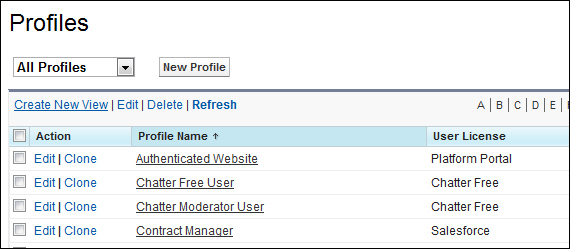
Following are the three steps to produce the list of profiles that allow you to modify multiple profile settings at once:
Enter View Name
Specify Filter Criteria
Select Columns to Display

Now that the profile view has been created, we can select multiple profiles to manage all at once as shown in the following screenshot:
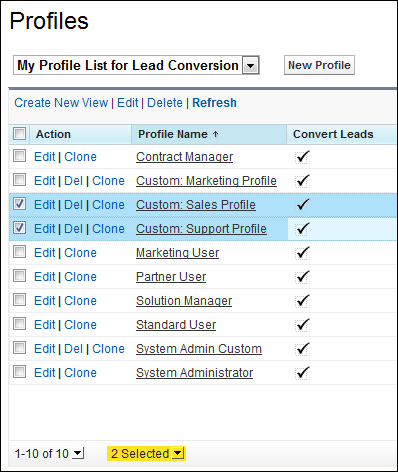
You can display the multiple lists of profiles that can be selected and actioned as follows:
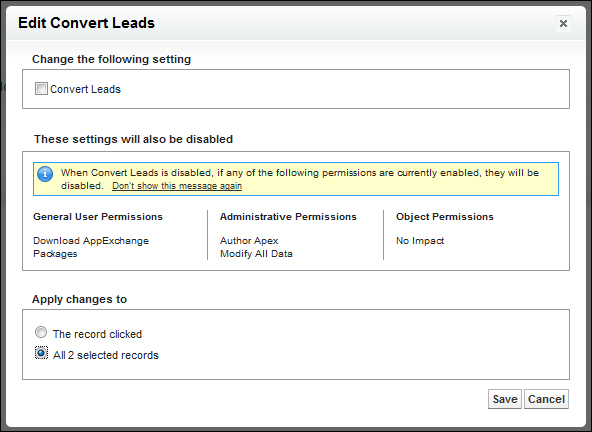
You can also modify the multiple profile selection to apply the setting to all the profiles as shown in the following screenshot:
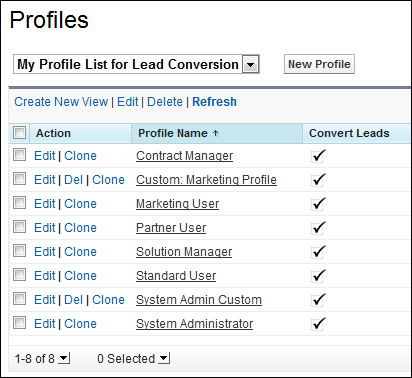
The Advanced settings of User Interface set up the screen currently related to the Extended Mail Merge features.
This option allows you to enable the Enhanced Profile User Interface, which then offers the following features to help you:
Find permissions and settings. Here, you can start typing a specific permission or setting name in the Find Settings box and then choose from a list of matching results.
Edit profile properties. Here, you can change the name or description of a profile.
Find out who belongs to a profile by clicking on the Assigned Users button to see a list.
Browse permissions and settings, for both, app and system properties. Here, the app-related and system permissions and settings are grouped on individual pages where the profile overview page provides the descriptions and links.

Select the Enable Custom Object Truncate checkbox to activate truncating custom objects, which permanently removes all of the records from a custom object while keeping the object and its metadata intact for future use.
Note
When this option is enabled, a Truncate button appears in the list of edit buttons within the custom object setup page.
Truncating custom objects is a quick way to permanently delete all of the records from a custom object, for example, if a custom object has been created and filled with test records. When testing is complete and the test data is no longer required, you can truncate the object to remove the test records, but keep the object ready to be deployed into production. This is much quicker than batch-deleting records and having to recreate the custom object.
Note
Truncating a custom object permanently removes all of its records, and you cannot recover the records from the Recycle Bin. A copy of the truncated object appears in the Deleted Objects list for 15 days, during which the object and its records continue to count towards the organization data limits. The copied object and its records are then permanently deleted after 15 days.
Advanced settings provides the activation of two features, namely the activation of Extended Mail Merge and the option to Always save Extended Mail Merge documents to the Documents tab.
Note
The Advanced settings option appears when your organization has enabled Extended Mail Merge, currently available by request to Salesforce customer support.
This option enables the Mass Mail Merge link to be available in the Tools area on the home pages for accounts, contacts, and leads.
When enabled, this option also sets single mail merges requested from the Activity History related list on a record to be created with the Extended Mail Merge function. The Extended Mail Merge function is activated using a wizard comprising of the following steps:
In the Tools area, click on Mass Mail Merge to start the mass mail merge wizard. Choose a list view from the View drop-down list and select the records to include in the mail merge. Selecting the checkbox in the column header will select all records currently displayed on the page.
Select the types of Word documents to generate from the multiple selections of documents, envelopes, and labels. Select the optional Log an activity... checkbox to log the creation of these mail merge documents, which adds a completed task to each record.
Select the appropriate mail merge templates. For documents, choose whether to create one Word document that includes all the outputs or a separate Word document for each record. Click on the optional Preview Template button to review the preloaded mail merge template.
Although the document preview is editable, do not edit in Word as the changes will not be saved to your current mail merge request. You have to make a new mail merge template and upload this first.
Note
With Extended Mail Merge, the mail merge operation cannot exceed 1000 records; the selected mail merge template's total size cannot be greater than 1 Mbytes, and the number of records multiplied by the combined size of the mail merge templates cannot be greater than 50 Mbytes.
Also, Extended Mail Merge is available by sending a request to Salesforce customer support.
This option stops the sending of the mail merge documents as e-mail attachments, and instead stores them in the user's personal documents folder on the Documents tab. Users are still sent e-mails as confirmation when their mail merge requests have completed, and these e-mails contain links to the documents in the Documents tab.
Note
These documents count against your organization's storage limits.
The Salesforce user interface includes pop-up windows, therefore, pop-up blockers must be disabled for the Salesforce domain.
A way to check that a user's browser allows pop-up windows is as follows:
Click on Your Name | Setup | My Personal Information | Reminders, and then click on Preview Reminder Alert.
Salesforce.com uses custom algorithms that consider the following within searches:
The search terms
Ignored words in search terms (for example, the, to, and for)
Search term stems (for example, searching for speaking returns items with speak)
Proximity of search terms in a record
Record ownership and most recently accessed records
A user might therefore not have the same search results as another user performing the same search because searches are configured for the user performing the search. For example, a user recently viewed a record, the record relevancy increases, and the record moves higher in their search results list. Records that are owned by the user also move higher in their search results. There are currently three types of search, as follows:
From the Sidebar Search box, users can search a subset of record types and fields. Wildcards and filters can be used to help refine the search.
Note
A wildcard is a special character or token that can be used to substitute for any other character or characters in a string. For example, the asterisk character (*) substitutes for zero or more characters. More information about the wildcard characters can be found using the following link: http://en.wikipedia.org/wiki/Wildcard_character
The Advanced Search in the sidebar allows searching for a subset of record types in combination and offers more fields including custom fields and long text fields, such as descriptions, notes, task, and event comments. Wildcards and filters can be used to help refine the search.
From the Global Search box, users can search more types of records, including articles, documents, products, solutions, chatter feeds, and groups. Users can also search more fields, including custom fields and long text fields such as descriptions, notes, tasks, and event comments. Wildcards and filters can be used to help refine the search.
Note
To enable Global Search, you must enable Chatter. If Global Search is enabled, Sidebar Search and Advanced Search are disabled.
Global Search is not supported in Partner Portal or Customer Portal.
Only users with supported browsers can use Global Search, as it has indirect dependencies on the New Theme user interface.
Your search term must have two or more characters. Special characters, such as ", ?, *, (, and ) are not included in the character count. For example, a search for m* will fail to return any search results.
Search terms are not case-sensitive. For example, a search for martin returns the same results as the search for Martin.
Finding phone numbers can be done by entering part or all of a number. For example, to find (512) 757-6000, enter 5127576000, 757, or 6000. To search for the last seven digits, you must enter the punctuation, such as 757-6000.
In Chinese, Japanese, and Korean, you can find a person by entering the last name before the first name; searching for howard trevor returns any person named Trevor Howard.
Tip
If you're using Advanced Search or Global Search, refine your search using operators such as AND, OR, and AND NOT.
If you're using Advanced Search or Global Search, search for exact phrases by selecting the Exact phrase checkbox, or by putting quotation marks around multiple keywords; for example, "phone martin brown" returns results with phone martin brown, but not martin brown phoned or phone martina browning.
If you're using Sidebar Search, your search string is automatically treated as a phrase search.
Search for partially matching terms using wildcards as follows:
Asterisks match one or more characters at the middle or end (not the beginning) of your search term. For example, a search for brown* finds items that start with variations of the term brown, such as browning or brownlow. A search for ma* brown finds items with martin brown or mandy brown. If you're using Sidebar Search, an * is automatically appended at the end of the search string.
If you're using Global Search, question marks match only one character in the middle (not the beginning or end) of your search term. For example, a search for ti?a finds items with the term tina or tika, but not tia or tinas.
If using Sidebar Search or Advanced Search, question marks match only one character in the middle or end (not the beginning) of your search term.
There are various search options that can be customized to change the way information can be searched by your users in Salesforce. These options either present enhanced search features that are visible as a part of the user interface, or are non-visible and used to optimize searching behind the scenes. The search settings can be set by navigating to Your Name | Setup | App Setup | Customize | Search | Search Settings.
The following screenshot shows the search settings that are available if Chatter is not activated in your Salesforce CRM application:
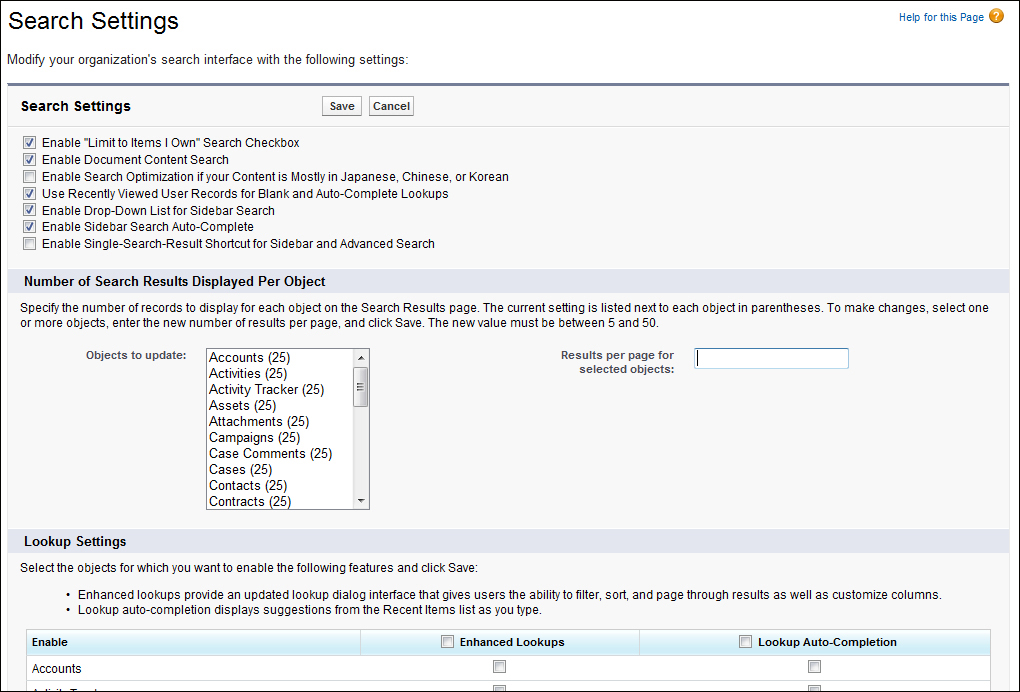
By activating Chatter, the Global Search setting is automatically enabled and provides the following reduced set of options:

In the following sections, you will see how to work with various search settings:
The Limit to Items I Own option allows your users to restrict the search results to find only the records of which they are the record owner when searching in the sidebar.
This option allows users to perform a full text search of a document. When new documents are uploaded or an existing document is updated, its contents are available as search terms to retrieve the document.
This option optimizes searching for Japanese, Chinese, and Korean language sets. It affects Sidebar Search and the account search for Find Duplicates on a lead record in Sidebar Search and Global Search.
This option causes the list of records returned from a user autocomplete lookup and from a blank user lookup to be generated from the user's recently viewed user records. By not enabling this option, the dialog shows a list of recently accessed user records from across your organization.
This option creates a drop-down list in the Search section to appear that allows users to limit searches by the type of record.
This option provides the functionality that when users start typing search terms, the Sidebar Search displays a matching list of recently viewed records.
This option allows users to skip the search results page and navigate directly to the record detail page if their search produces a single result.
The Number of Search Results Displayed Per Object area allows you to configure the number of items that are returned for each object in the Search Results page. The current setting is in brackets next to each object where the new value must be between 5 and 50.
The Lookup Settings section of the Search Settings page allows you to enable enhanced lookups and lookup autocompletion for Accounts, Contacts, Users, and custom objects.
Enhanced lookups provides an enhanced interface for your users to sort and filter search results by any field that is available in regular search results, as shown in the following screenshot:

With enhanced lookups enabled, users can hide and reorganize the columns that are displayed in the results window. Enhanced lookups return all records that match the search criteria and allow you to page through large sets of search results.
After enabling enhanced lookups, you must specify which fields users can use to filter lookup search dialog results. This is set by accessing search layouts and choosing the fields from the Lookup Dialog Fields layout.
For custom objects, this is done by navigating to Your Name | Setup | Create | Objects. Choose the object you want to modify, scroll down to the Search Layouts related list, and choose the fields from the Lookup Dialog Fields.
For Accounts, Contacts, or Users, this is done by navigating to Your Name | Setup | App Setup | Customize, go to Accounts, Contacts, or Users, and then Search Layouts. Then, choose the fields from the Lookup Dialog Fields as shown in the following screenshot:

Currently, only Accounts, Contacts, Events, Users, Chatter objects, and custom objects can be enabled to use the enhanced lookup settings.
This chapter looked at the mechanisms in place to help manage login access to the Salesforce CRM application and how organization-wide settings can be set to determine your company-specific information within Salesforce.com.
The options to configure the look and feel of the application were identified along with details of the methods for searching for information in Salesforce.
Notes and tips gained from the experience of Salesforce CRM system administration were outlined to help guide the understanding and improve the implementation of these features.
Having looked at these core customization feature sets, we will now look at how profiles and sharing in Salesforce CRM govern what functionality and access permissions a user has throughout the application.




















